‘It is a fertile land, with streams, orchards, palm gardens and fruit trees of various kinds… has fine bazaars and splendid clean mosques…’ wrote Ibn Battuta in his epic tome, Travels in Asia and Africa 1325 – 1354 about Oman. The only medieval traveller who visited the countries of every Muslim ruler of his time as well as Sri Lanka, China and parts of Russia during the course of his momentous 75,000 mile journey – a feat that remained unsurpassed till the advent of steam engines – Battuta set sail from his Tangiers home in Morocco in 1325. Four years later, he arrived by sea at Sur in northeast Oman, on the coast by the Gulf of Oman, 150 km from capital Muscat. If I were to visit Oman, I’d let the intrepid Battuta take me around, happy to follow in his footsteps, reposing my trust in his ‘touch of intimate to bring it live again for the reader’ – as the claim goes at the beginning of Travels.
Even as early as from the sixth century, Sur was an established centre of trade and was renowned for its ship building industry. The sambuqs, or traditional wooden trading vessels, built here were in great demand all over the world; the dhows built today carry forward the town’s legacy of trustworthy seafaring vessels. ‘From here,’ wrote Battuta, ‘we saw the city of Qalhat on the slope of a hill, and seeming to be close by.’ It would have looked ‘close by’ to him but the city is actually 20 km away; a walk he undertook with the Indian Khadir over boulder-strewn paths and gulches. Here Battuta mentions visiting the famous mausoleum of the saintly lady Bibi Maryam who ruled the city a few years before his visit.
‘The city of Qalhat is on the coast. It has good markets and one of the most beautiful mosques in the world. The walls of the mosque are covered with blue ceramic tiles. It stands on a hill beside the harbour. This mosque was built by an important woman named Bibi Maryam. The people here are merchants and they bring many goods from India. When a ship arrives the people are very happy.’ Battuta wrote in Travels about the mausoleum and of Qalhat, which was originally the capital of Oman. Though the mosque is in ruins today, Qalhat has a host of other ancient monuments including the Bilad Sur, Al Ayjah, Fanar Ras Al Meel and Ras Al Hadd castles. The valleys like the Wadi Shab and Wadi Tiwi are very scenic ones which I wouldn’t want to miss. ‘Wadi Tiwi’, Battuta wrote, ‘is one of the loveliest of villages and most striking in beauty, with flowing streams and verdant trees and abundant plantations.’ Activities: While at Sur, I’d like to go with the fishermen in a traditional dhow out into the open sea; a spot of fishing, perhaps. Back on land, I’d then learn to have coffee the Omani way: in small cups, filled to a quarter, thrown back in appreciative – neither too loud, nor low – slurps.
The Arabophone city of Dhofar – Zafar, in Arabic, as it was known during Battuta’s visit – traces the southern coast of the Arabian peninsula. Though the town is far removed from the rest of Oman, more than 900 km from Muscat, this is a fabled territory of seeping history and hidden riches. ‘The people of Dhofar are traders,’ wrote Battuta in Travels who were very generous as well. ‘When a ship arrives, everyone on board is granted hospitality for three days…They manufacture silk, cotton and linen cloth of excellent quality.’ The remains of Arabic country’s oldest and most cosmopolitan of cultures can be found here as the source of the legendary frankincense trade. Although not a bustling trade anymore, the incense market in capital Salalah is still a huge attraction for natives and tourists alike. The shops that spill over into the pavements, hundreds of thousands of bottles of incense, curiously-shaped containers of an eclectic mix of ingredients – many of them family secrets held for generations, the suq – market – is run mostly by ladies. Hawjiri, from the Jebel Samhan, the mountains behind Hasik, is apparently a much sought-after fragrance. Other attractions: The wadis and gorges of the Jebel Samhan and Jebel al Qamar which form the scenic Dhofar Mountains. There are many activities I’d like to take part while at Dhofar like watch a local wedding in Salalah for the sheer opulence and gaiety of customs; Dig into regional specialties like Sultan Ibrahim, a fish preparation, fried and dipped in sesame paste, chicken Mulukhiya (meaning ‘of the kings’) and mutton with garlic and okra.
About 40 km off Dhofar, east of Hasik, lies the archipelago of four small islands poetically called the Khuriya Muriya; the largest one is called the Hallaniyah Island, hence the alternative, modern name, Hallaniyah or Hallaniyat. Ibn Battuta during his visit here met many hermits who had made isolated hilltops their homes. Even today the islands have plenty of picturesque buttes, quiet wadis and scenic ports; diving here is growing in popularity. Besides the usual activities on offer – fishing is organised here on boats from Hasik*, Sadah and Mirbat – I would like to visit the grave of a sayyid – who are believed to protect people from evil. The grave of Sayyid Sa’id is a revered destination, a sort of pilgrimage spot for the fisher folk from the area. In every probability the closest I’d get to be near a saint about whom Battuta have described in reams. *Hasik is another important Battutian destination in Oman which is famous for its frankincense as mentioned earlier. In his Travels, he noted that ‘The frankincense trees have thin leaves and when a leaf is slashed there drips from it a sap like milk which turns into a gum.’ Watching a demonstration on how to tap the sap would be an intriguing as well as an informative activity while at Hasik.
While I have let Battuta take me around till now, for this one I’d like to return him the favour of ‘bringing it live’. Then anyway he’d have to let me take the lead here – for dune bashing is of recent origin. The gigantic dunes of Wahiba Sands, about a four hour drive from Muscat, are a dune-basher delight. The searing wind has carefully sculpted the sand into crests and numerous crenellations, some leviathans even looming at over 100 metres! Roaring up the dune and sliding down the other side, spending a night of fun and frolic in the desert… going by his penchant for adventure I’m sure Battuta would have been game for a ride.
The images are courtesy of Deepa Jose, my sister, who was a teacher at Nizwa and Muscat for many years; the ‘Shop in Salalah’ is by Usha George, her friend and colleague.
This is an entry for a contest run by Indiblogger.in and organised by the Ministry of Tourism, Sultanate of Oman.



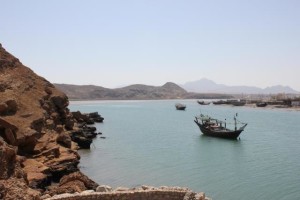
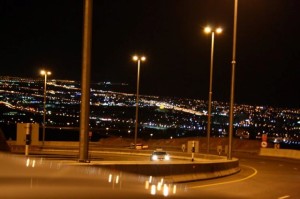
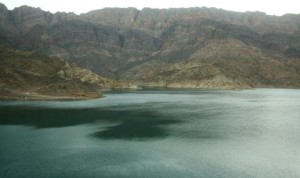
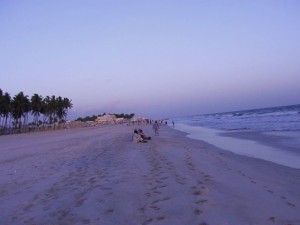
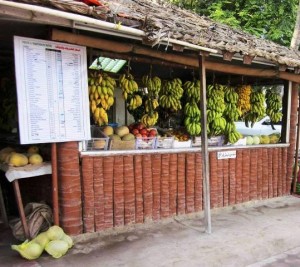
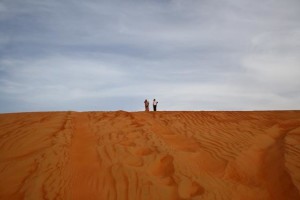









The Wadi Tiwi looks so promising! Thanks for introducing me to it 🙂
I read about the Wadi Shab and included that in my dream list!
Ain’t it so inviting!
Good post with a bit of history… Ibn Batuta part is really informative
Thanks Prasad… Ibn Battuta is my icon, want to follow his footsteps someday!